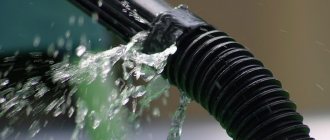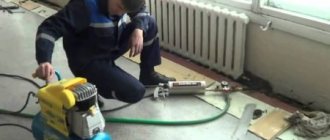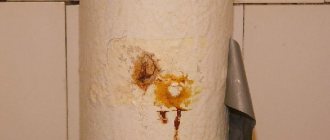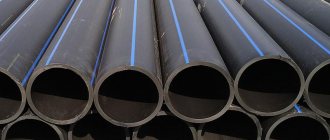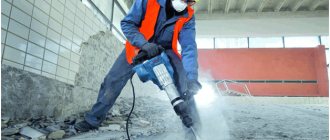When using HDPE pipes, there are situations when it is necessary to eliminate a leak. HDPE pipes themselves are practically indestructible if hidden in the ground and not exposed to UV radiation, but they are practically defenseless against shovels and evil forces. Moreover, damage and leakage may not appear immediately, but only after a good supply of water. It's nice that it's quite easy to fix the leak. The easiest way to do this is with a suitable fitting. In the same way, you can make a cut into an already laid pipe if necessary. You just need to take a tee.
HDPE fittings can be found on the quadropolimer website.
Well, then step by step. Everything is easy and simple.
Emergency repair without draining coolant
Possible if the water does not stream, but simply drips.
1. Crimp with a screw clamp without using glue. Let's take advantage of some of the elasticity of polypropylene. A crimp clamp is applied to the coupling from which it is leaking. After tightening the screw, the leak will decrease and possibly disappear altogether. You can leave it like this until the end of the heating season. But when the temperature of the coolant changes, polypropylene contracts and expands. You will have to constantly monitor the joint.
Therefore, it would be more correct to additionally seal the connection using an adhesive.
2. Application of “cold welding”. Most of these compounds can be used in damp environments.
The main thing is that the binding force of the glue can withstand the pressure of flowing water. This is where preventive crimping of the coupling using a clamp will help. Simply covering up the leak is not enough. After several temperature changes, micro gaps will appear between the glue and the pipe, and the flow will resume. For reliability, it is necessary to install another supporting coupling opposite the defective joint, let’s call it a repair coupling. It is cut from standard connecting fittings. To put it on the pipe, we make a longitudinal cut (cut).
We clean the pipe with sandpaper, degrease it, and dry the leak area if possible.
We put a repair coupling on the pipe, prepare “cold welding” glue, and cover the leak area. We move the coupling to the joint, fix it with a second clamp.
In this case, the glue will compact between the couplings and fix the leak. Due to the mixing of “cold welding” with water, the appearance is not very aesthetic. This does not affect the strength (the glue is designed for such use).
The goal has been achieved: the leak has been eliminated. But this solution is temporary; the epoxy glue will gradually crack.
How to seal a cast iron pipe joint
Now let’s talk about how to cover the joints between adjacent pipes. The leak is eliminated as follows:
- the bell is hammered out;
- Remains of tow, cement and other debris are removed;
- all elements are dried with a hair dryer;
- a sanitary winding made from flax is stuffed into the gap;
- with an aqueous solution mixed with PVA glue and cement, it is necessary to waterproof the joint several times.
Sewer pipe repair can be carried out in different ways. Depending on the complexity of eliminating the defect, the following materials and tools are used:
- clamps;
- silicate glue;
- sandpaper;
- solvent;
- bandage;
- cement mortar;
- acetone;
- copper oxide;
- orthophosphoric acid;
- silicone sealant;
- self-adhesive tape;
- rags;
- metal brush;
- Screwdriver Set;
- container for cement mortar;
- mounting gun;
- synthetic brush;
- putty knife;
- construction hairdryer
Repair of polypropylene pipes in hard-to-reach places
It is not always convenient to carry out repair work directly at the accident site. The difficulty lies in using a soldering iron, since the process is carried out in a limited space.
Plumbers work
In this case, to perform welding, perform the following steps:
- The tool is prepared and checked.
- Burrs, dust, dirt and grease are removed from the surfaces being welded. Degreasing is performed with wipes soaked in solvent or white spirit. The substance used must be completely dry.
- The soldering iron heats up to 260 °C.
- The hot pipe nozzle is removed using a gas wrench and quickly put on the pipe in a hard-to-reach place. At the same time, the fitting is heated on the soldering iron.
- The nozzle is removed from the pipeline element in a limited space, and the connecting part is removed from the tool.
- The heated PP parts of the pipeline system are joined.
The repair process in difficult places can also be carried out using a classic fitting with a union nut - an American one. It can be easily installed and removed. This fitting allows you to quickly remove the system assembly for repair or complete replacement. American provides a high level of tightness.
Manufacturers produce American fittings with internal, external threads and mixed types. They are made from various alloys, including steel and brass. American ones are produced in the form of plugs, crosses, tees and adapter couplings.
Sealant and epoxy glue
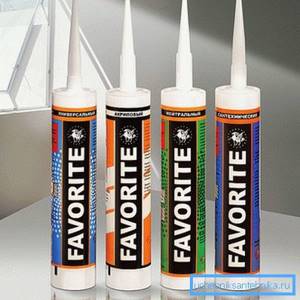
There can be a large number of possible circumstances for the appearance of cracks or leaks in plastic pipes. This could also be a violation of installation rules, incorrect operation, or a simple manufacturing defect. If the crack is small, you may not need to replace it, but try to seal the pipe.
The first method to carry out repair work is the use of silicone sealant. This method is suitable when the crack is not through. In most cases, this method is used when repairing sewer pipes. The flow of work will be as follows:
Video on the topic
Thanks to the advent of PP pipes, not only the installation of utilities has been simplified, but also the repair of systems. Now, in case of leaks, the work can be done by a non-professional. The main thing is to know the methods and technology of the processes.
The video will help you better understand the nuances of eliminating a leak in a PP pipeline.
Drilled a polypropylene pipe into the wall
How to solder a hole in a polypropylene pipe
How to seal a polypropylene pipe
How to solve the leak problem
When spring arrived, the leak was discovered. The solution turned out to be very simple, but out of habit we began to look for someone who had a special tool that was used to heat the pipes to connect them. It took so much time to search, and finally the bright idea came to take an old iron.
I didn’t even have to apply additional plastic; the part that was turned outward by the ice was enough. The iron melted it very well and closed the leak. Now I use this simple method in any similar cases.
Using Cold Welding
An effective way to reliably seal a leak is to use cold welding to repair plastic pipes. This is a special repair compound that needs to be applied to the problem area. The material is sold in specialized stores.
The pipe surface to be repaired is first cleaned with sandpaper, thoroughly degreased and dried. After this, you need to take a sufficient amount of cold welding and knead it thoroughly. In this case, your hands should be wearing moistened rubber gloves. The material is kneaded until it changes color to brown and acquires the consistency of plasticine. The prepared mass must be applied to the area to be repaired and pressed tightly with a tourniquet, leaving it there for an hour. During this time, the cold weld will harden and form an almost monolithic connection with the plastic.
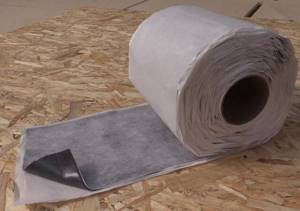
RESULTS ºÑƒ в пР»Ð°Ñ тиковой трубе
Silicone sealant
Sealing of joints and cracks in cast iron sewers is also carried out by other specialized means. These include silicone sealant, which is characterized by excellent adhesive properties regardless of the type of surface.
Silicone sealants are divided into:
- acidic;
- neutral.
The first products are not recommended to be applied to a surface that comes into contact with an aggressive environment. Neutral sealants are universal products.
Silicone sealant is applied to the damaged surface using a mounting gun. The vulcanization process is facilitated by moisture in the air. Silicone paste turns into a substance that has similar characteristics to rubber.
As alternative options for sealing cast iron pipes at home, the following are used:
- Portland cement;
- jute or hemp rope;
- epoxy resin;
- technical sulfur.
Causes of leaks
In non-pressure systems, emergency situations arise due to improper operation, poor-quality installation and manufacturing defects. A connection made incorrectly always causes network depressurization.

I drilled a polypropylene pipe into the wall, what should I do?
Polypropylene is not difficult to damage due to mechanical stress. Most often, leaks in a free-flow system occur precisely because of external interference. Mechanical stress negatively affects rubber sealing elements, which are used to make most connections in non-pressure networks.
In systems under pressure, accidents occur for the following reasons:
- physical impact;
- incorrect installation;
- non-compliance with recommendations during operation;
- increased blood pressure;
- erroneous assembly;
- use of low-quality materials.
Often, a violation of the tightness of the PP system occurs during repair and construction work. Often installers or builders drill into pipelines.
The cause of the emergency can also be factory defects, because there are polymer pipes made in China.
PP products have a durability of 50 years. This is exactly the guarantee that bona fide manufacturers of certified products issue.
Long-term repair
It can be carried out after the end of the heating season, when the system is drained for prevention.
We clean the leak site from temporary repairs, sand and degrease the surface. We put a repair coupling on the pipe.
We apply a layer of RTV sealant; you can use a mirror to control invisible areas.
We move the repair coupling until the sealant appears from the gap.
Coat the surface with a layer of sealant 2-3 mm thick. Be sure to fill in the repair coupling section.
We make a bandage from a sheet of galvanized sheet or thin PVC sheet. We wrap around the junction of the couplings. The cut location of the bandage should not coincide with the leak point.
We put on the second bandage on top, turning the incision site 180°.
We put on threaded clamps and tighten the bandage couplings tightly. Excess sealant should be squeezed out of all joints and crevices. This means that there are no air voids left inside the repair area and the connection is airtight.
After final tightening, remove excess sealant.
Schematically, the repair area looks like this:
It is important that the leak point, the cuts on the repair coupling and bandages, are in different sectors. After 12 hours, the connection will gain the necessary strength. RTV sealant maintains plasticity and compensates for thermal gaps when the temperature of the coolant changes. So there will definitely not be any leakage in this place.
Of course, materials have some price. But the cost of a plumber's work is much higher. In addition, there is no need to disassemble the leaking unit and install new pipes.
I was prompted to write such an article by the complete lack of adequate information on the Internet. Despite the many reviews when forming a search query on the topic, there are no really working tips in principle. As a result, a solution was found independently; the sealed leak has not manifested itself for two heating seasons.
How to repair a leak in a plastic pipe - step-by-step instructions
When a plastic pipe leaks at the junction, it is important to solve this problem in a timely and prompt manner using one of the proposed methods:
- Cold welding - turn off the water supply, prepare the component for sealing the crack, knead it, apply it to the damaged area, and then wait until it hardens;
- Glue bandage - take two clamps and a piece of material soaked in glue, install it in the area of the leak, tighten the screws. The method is not recommended for pipes under pressure;
- Sealing tape - it is wound around the joint in several layers, making sure that the material fits as tightly as possible;
- Sealant - degrease the damaged area, and then apply a special compound. It can be neutral, acidic or silicone, the latter is considered universal.
In the event of a water pipe leak hidden under the finishing, it will have to be partially dismantled; there is no other way to get to the scene of the accident.
Today it is not at all uncommon for a plastic pipe to leak at the junction in apartments.
How to repair the damage? Use clamps, sealant or cold welding, but keep in mind that these methods are only a temporary solution; often a complete replacement of the damaged area is required, eliminating future flooding. Although this involves additional costs, it is as reliable as possible. Back to list Share: Send link
